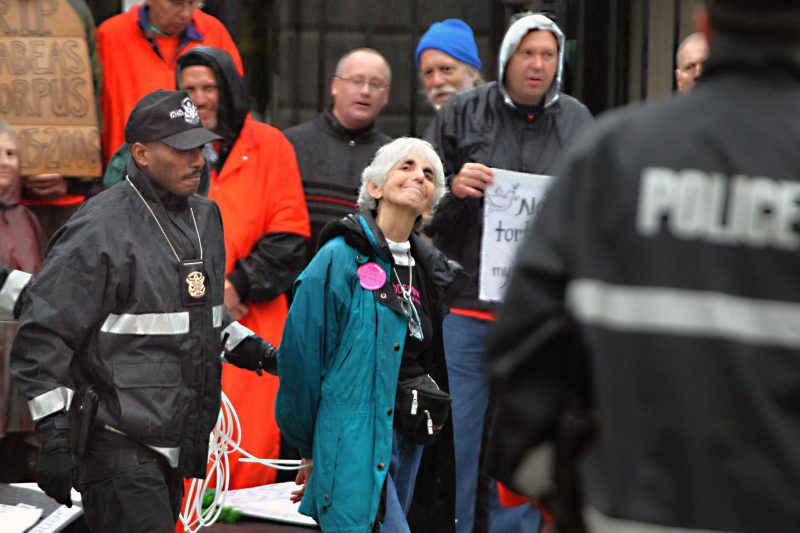Eve Tetaz, a retired Washington educator who joined rights groups at demonstrations into her 80s, facing arrest about 20 times while protesting the wars in Afghanistan and Iraq and the detentions at the U.S. military prison at Guantánamo Bay, died June 7 at an assisted-living center in Washington. She was 91.
Ms. Tetaz had dementia, her sister Ann Barnet said.
Ms. Tetaz was taken into custody so often — once while wearing an orange prison jumpsuit in front of the White House — that police and judges came to know her by her first name. With her crown of white hair, she was a distinctive presence at many protests and marches in the District.
Ms. Tetaz said she was drawn to religious traditions emphasizing social justice, which inspired generations of protesters, including antiwar marches beginning in the Vietnam era. In an article in the bulletin of Washington’s Church of the Saviour, she wrote that she felt a deep empathy for society’s outcasts, even as a small child.
“I believe that nonviolent protest against government policies will continue to be the only authentic form of individual political action,” Ms. Tetaz read from a statement during a sentencing hearing in D.C. Superior Court in 2010.
As the U.S. wars in Afghanistan and Iraq dragged on, Ms. Tetaz joined organizations including the women’s group Code Pink, the National Campaign for Nonviolent Resistance and Witness Against Torture.
She joined rallies calling for an end to the wars and decrying the treatment of detainees at Guantánamo Bay. She also took part in demonstrations denouncing the death penalty and U.S. military policies.
She participated in nonviolent civil resistance demonstrations on Capitol Hill and in front of the Supreme Court and White House from 2006 to 2013.
After most arrests, she received probation, a fine and other penalties. But in 2012, when she was 80, she was arrested at the Supreme Court for holding a protest banner marking the 35th anniversary of the execution of convicted murderer Gary Gilmore, who was killed by firing squad in January 1977 in Utah. Gilmore was the first inmate put to death after the Supreme Court struck down a ban on capital punishment.
After declining prosecutors’ recommendation of a fine and probation, Ms. Tetaz was sentenced to 60 days in jail. It is unlawful to parade, stand or move in processions or assemblages in the Supreme Court Building or grounds.
Behind bars, Ms. Tetaz tutored inmates, who called her “Grandma,” her sister said. Ms. Tetaz was released early on medical grounds.
In April 2009, she traveled to the Creech Air Force Base in Nevada to protest the use of remote-controlled drones in military missions and was one of 14 protesters arrested for trespassing. She told the Las Vegas Review-Journal that she had gone to Creech “to express deep sorrow and outrage that our country was engaged in what I believe are acts of terrorism. I cannot remain silent.”
Later that year, she was one of four activists who clandestinely attended a Senate Foreign Relations Committee hearing and interrupted the proceedings by throwing handfuls of money stained with their own blood.
Ms. Tetaz taught English at the District’s Roosevelt High School in the 1980s and later served on the faculty of the Armstrong Adult Education Center, where she helped students attain their high school equivalency degree.
“Eve would always say, ‘I’m the perfect person for this because I have no responsibilities, no children, no grandchildren,’” her sister said. “‘Who better than I to do this.’”
Eve Leona Birnbaum was born on Sept. 6, 1931, in Elmhurst, Ill., a suburb of Chicago. Her father was a Romanian immigrant of Jewish heritage who converted to Christianity and became a Presbyterian minister. Her mother was a homemaker.
The family moved to Brooklyn when she was 8 years old. She received a bachelor’s degree from Brooklyn College and earned a master’s degree in religious studies from New York Theological Seminary. She taught at a junior high school in Harlem and spent a summer as a reading specialist in Orleans, France.
In the 1960s and 1970s, she taught English in Iran, Thailand, France and Ghana.
She married Rene Tetaz in 1972, and the couple lived in Africa and Asia while he worked on assignment with the U.S. Agency for International Development. He died in 1995. Survivors include her sister.
“She was always searching for a deeper engagement,” said Marja Hilfiker, who met Ms. Tetaz at the Church of the Saviour, “and she found that in protesting all the wrongs in the world.”








